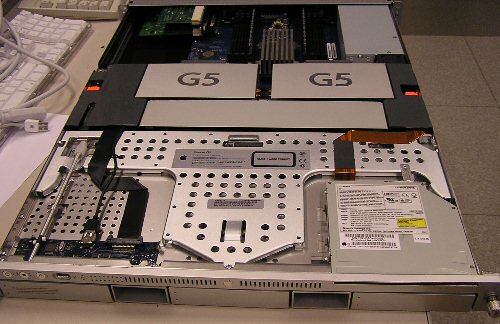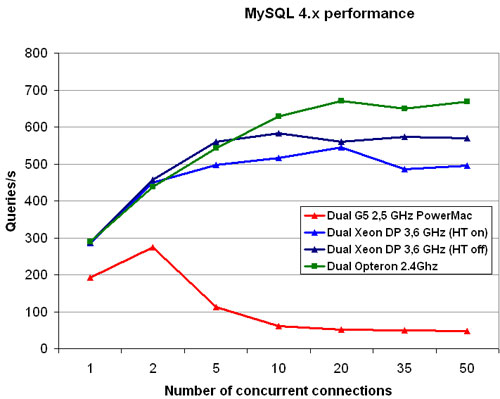No more mysteries: Apple's G5 versus x86, Mac OS X versus Linux
by Johan De Gelas on June 3, 2005 7:48 AM EST- Posted in
- Mac
The G5 as Server CPU
While it is the Xserve and not the PowerMac that is Apple's server platform, we could not resist the temptation to test the G5 based machine as a server too. Installed on the machine was the server version of Mac OS X Tiger. So in fact, we are giving the Apple platform a small advantage: the 2.5 GHz CPUs are a bit faster than the 2.3 GHz of the Xserve, and the RAM doesn't use ECC as in the Xserve.


| Dual G5 2,5 GHz PowerMac | Dual Xeon DP 3,6 GHz (HT on) | Dual Xeon DP 3,6 GHz (HT out) | Dual Opteron 2.4Ghz | |
| 1 | 192 | 286 | 287 | 290 |
| 2 | 274 | 450 | 457 | 438 |
| 5 | 113 | 497 | 559 | 543 |
| 10 | 62 | 517 | 583 | 629 |
| 20 | 50 | 545 | 561 | 670 |
| 35 | 50 | 486 | 573 | 650 |
| 50 | 47 | 495 | 570 | 669 |
Performance is at that point only 1/10th of the Opteron and Xeon. We have tested this on Panther (10.3) and on Tiger (10.4.1), triple-checked every possible error and the result remains the same: something is terribly wrong with the MySQL server performance.
SPEC CPU 2000 Int numbers compiled with GCC show that the G5 reaches about 75% of the integer performance of an equally clocked Opteron. So, the purely integer performance is not the issue. The Opteron should be quite faster, but not 10 times faster.
We checked with the activity monitor, and the CPUs were indeed working hard: up to 185% CPU load on the MySQL process. Notice that the MySQL process consists of no less than 60 threads.

| Concurrency | Dual Powermac G5 2.5 GHz (Panther) | Dual Powermac G5 2.7 GHz (Tiger) | Dual Xeon 3.6 GHz |
| 5 | 216.34 | 217.6 | 3776.44 |
| 20 | 216.24 | 217.68 | 3711.4 |
| 50 | 269.38 | 218.32 | 3624.63 |
| 100 | 249.51 | 217.69 | 3768.89 |
| 150 | 268.59 | 256.89 | 3600.1 |
The new OS, Tiger doesn't help: the 2.7 GHz (10.4.1) is as fast as the 2.5 GHz on Panther (10.3). More importantly, Apache shows exactly the same picture as MySQL: performance is 10 times more worse than on the Xeon (and Opteron) on Linux. Apple is very proud about the Mac OS X Unix roots, but it seems that the typical Unix/Linux software isn't too fond of Apple. Let us find out what happened!










116 Comments
View All Comments
Reflex - Friday, June 3, 2005 - link
NT was designed primarily by Dave Cutler, who was one of the guys behind VMS at DEC. NT is not based on Mach and has no relation to it, although it shares some similarities with BSD and VMS.tfranzese - Friday, June 3, 2005 - link
#35, Apple's platform uses HT links (don't ask me specifics).minsctdp - Friday, June 3, 2005 - link
What's with the 24 MB/s memory write time on the Xeon, vs. nearly 2GB/s for the others? Looks bogus.querymc - Friday, June 3, 2005 - link
I'd still like to see a Linux on G5 test. Without one, we still don't know for sure whether the bad performance is due to OS X or the hardware. And it's definitely useful for G5 owners to know whether they can expect Linux to improve server performance.querymc - Friday, June 3, 2005 - link
NT is not built on Mach. NT itself was originally a microkernel-based OS, derived from the design of DEC's VMS OS via the lead architect of both, Dave Cutler. It's currently very monolithic, a bit more than OS X because they stuffed a lot of userspace cruft from Windows 9X in the XP kernel for binary compatibility.Rick Rashid(sp?) was one of the co-developers of Mach, and he went to Microsoft, which is probably what OddTSI is referring to. I don't recall whether he went to research or the OS group, though. Either way, NT has no Mach code and does not share Mach's design.
Netopia - Friday, June 3, 2005 - link
OddTSI (Poster 37)-- Do you have any supporting data for saying that NT is built on Mach?Joe
AluminumStudios - Friday, June 3, 2005 - link
Intersting article. I wish you hadn't left out AfterEffects though because I use it heavily and I'd love to see a comparison between the Mac and x86 on it.OddTSi - Friday, June 3, 2005 - link
There's a semi-big error in your discussion on page 7. NT (and the subsequent Windows OSes based on it) is NOT a monolithic OS. In fact NT is BASED ON MACH. The main developer for the Mach micro-kernel was one of the lead developers of NT.octanelover - Friday, June 3, 2005 - link
I think it would be interesting, on the server side of things, to include Solaris 10 on Opteron in your benchmark list. Seeing as how Solaris is still a major player in the server world it would be nice to see how it fares along with Linux and Mac OSX.By the way, this article, IMHO, is darn near groundbreaking. Excellent work and very illuminating.
exdeath - Friday, June 3, 2005 - link
And before we talk about 10 Gb/sec busses, don't forget the Opteron can have like what 3 HT channels?And Hyper Transport specs allow for 22 GB/sec per channel (11 GB/sec bidirectional?)